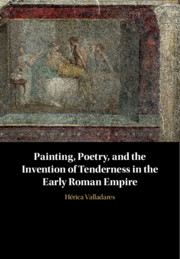Refine search
Actions for selected content:
5894 results in Classical art and architecture
Epilogue - Tenderness Transformed
-
- Book:
- Painting, Poetry, and the Invention of Tenderness in the Early Roman Empire
- Published online:
- 26 November 2020
- Print publication:
- 17 December 2020, pp 186-198
-
- Chapter
- Export citation
Three - The Tender Interior
-
- Book:
- Painting, Poetry, and the Invention of Tenderness in the Early Roman Empire
- Published online:
- 26 November 2020
- Print publication:
- 17 December 2020, pp 140-185
-
- Chapter
- Export citation
Bibliography
-
- Book:
- Painting, Poetry, and the Invention of Tenderness in the Early Roman Empire
- Published online:
- 26 November 2020
- Print publication:
- 17 December 2020, pp 223-238
-
- Chapter
- Export citation
Index
-
- Book:
- Painting, Poetry, and the Invention of Tenderness in the Early Roman Empire
- Published online:
- 26 November 2020
- Print publication:
- 17 December 2020, pp 239-248
-
- Chapter
- Export citation
Introduction - On Roman Tenderness
-
- Book:
- Painting, Poetry, and the Invention of Tenderness in the Early Roman Empire
- Published online:
- 26 November 2020
- Print publication:
- 17 December 2020, pp 1-30
-
- Chapter
- Export citation

Painting, Poetry, and the Invention of Tenderness in the Early Roman Empire
-
- Published online:
- 26 November 2020
- Print publication:
- 17 December 2020
Acknowledgements
-
- Book:
- The Social Dynamics of Roman Imperial Imagery
- Published online:
- 09 November 2020
- Print publication:
- 12 November 2020, pp xiv-xiv
-
- Chapter
- Export citation
8 - The Altar of P. Perelius Hedulus in Carthage and the Social Aspects of Provincial Image-Making
-
-
- Book:
- The Social Dynamics of Roman Imperial Imagery
- Published online:
- 09 November 2020
- Print publication:
- 12 November 2020, pp 180-214
-
- Chapter
- Export citation
2 - The Altars of the Lares Augusti
-
-
- Book:
- The Social Dynamics of Roman Imperial Imagery
- Published online:
- 09 November 2020
- Print publication:
- 12 November 2020, pp 25-51
-
- Chapter
- Export citation
Abbreviations
-
- Book:
- The Social Dynamics of Roman Imperial Imagery
- Published online:
- 09 November 2020
- Print publication:
- 12 November 2020, pp xv-xvi
-
- Chapter
- Export citation
11 - When Was an Imperial Image?
-
-
- Book:
- The Social Dynamics of Roman Imperial Imagery
- Published online:
- 09 November 2020
- Print publication:
- 12 November 2020, pp 275-288
-
- Chapter
- Export citation
Contributors
-
- Book:
- The Social Dynamics of Roman Imperial Imagery
- Published online:
- 09 November 2020
- Print publication:
- 12 November 2020, pp xiii-xiii
-
- Chapter
- Export citation
3 - Modelling the Emperor
-
-
- Book:
- The Social Dynamics of Roman Imperial Imagery
- Published online:
- 09 November 2020
- Print publication:
- 12 November 2020, pp 52-75
-
- Chapter
- Export citation
9 - Imagines et tituli
-
-
- Book:
- The Social Dynamics of Roman Imperial Imagery
- Published online:
- 09 November 2020
- Print publication:
- 12 November 2020, pp 215-246
-
- Chapter
- Export citation
10 - The Imperial Image in Media of Mechanical Reproduction
-
-
- Book:
- The Social Dynamics of Roman Imperial Imagery
- Published online:
- 09 November 2020
- Print publication:
- 12 November 2020, pp 247-274
-
- Chapter
- Export citation
Index
-
- Book:
- The Social Dynamics of Roman Imperial Imagery
- Published online:
- 09 November 2020
- Print publication:
- 12 November 2020, pp 289-292
-
- Chapter
- Export citation
1 - Introduction
-
-
- Book:
- The Social Dynamics of Roman Imperial Imagery
- Published online:
- 09 November 2020
- Print publication:
- 12 November 2020, pp 1-24
-
- Chapter
- Export citation
4 - Publica numina
-
-
- Book:
- The Social Dynamics of Roman Imperial Imagery
- Published online:
- 09 November 2020
- Print publication:
- 12 November 2020, pp 76-99
-
- Chapter
- Export citation
Contents
-
- Book:
- The Social Dynamics of Roman Imperial Imagery
- Published online:
- 09 November 2020
- Print publication:
- 12 November 2020, pp v-vi
-
- Chapter
- Export citation
Epigraphic Appendix
- from 9 - Imagines et tituli
-
- Book:
- The Social Dynamics of Roman Imperial Imagery
- Published online:
- 09 November 2020
- Print publication:
- 12 November 2020, pp 234-246
-
- Chapter
- Export citation
